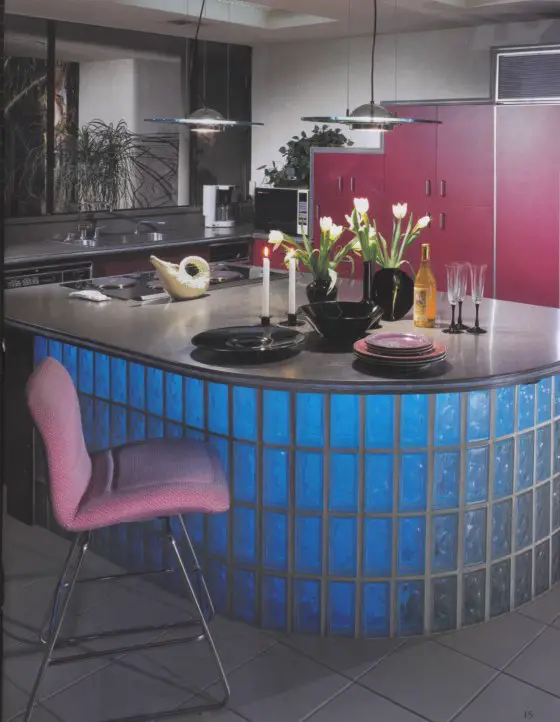Glass and Acrylic Blocks Do Many Things

DEAR TIM: I would like to jazz up a home I am renovating. Glass block has really got my attention. It seems like I can use it in numerous places but I wonder if there are limitations. Do you have some cool suggested uses for glass block other than windows? Is the block as easy to install as the television shows portray? I am skeptical to say the least. Mandy O., Riverside, CA
DEAR MANDY: I must compliment you on your choice of building materials. Glass block is indeed a unique building material that seems to blend with many architectural styles. In addition, it is a rare oxymoron building material. It can provide privacy, yet permit enormous amounts of light to pass from room to room or from outdoors to indoors. Don't feel that glass block is limited to renovation and remodeling as it is an excellent building material for new homes too.
Keep in mind that there are two types of clear building blocks: one is indeed made from glass but the other one is lightweight, crystal clear acrylic. The acrylic block is tough and virtually indestructible. Both types offer you tremendous design opportunities.
Two traditional rooms where you often find the greatest use of glass block are the bathroom and the kitchen. Glass block makes for a very contemporary shower stall. One of the coolest uses is to purchase a special molded shower base that has a wide ledge made especially for the waterproof glass block. One of the walls of the walk-in shower stall has a tight curve that eliminates the need for a shower door. It is similar to the entries into restrooms you often see at airports. Glass block can also be used as the support walls beneath a whirlpool tub and as a low wall around a whirlpool if you want to make a cozy retreat to soak in after a hard day at work.
Kitchen islands are a very interesting place to use glass block. You can highlight the block with colored lights to make the glass glow at night. Open shelving can be incorporated into the glass block for a very modern look. If you want, simply install two U-shaped glass block returns at either end of an island for a decorative look. Glass block can support a peninsula bar that is used for chatting or informal eating. If your cabinets are on exterior walls, glass block can be used as the backsplash connector between the countertop and the wall cabinets. They allow sunlight to stream into this otherwise hard to light location.
Combining glass block with a direct vent gas fireplace is another option. You can actually place the fireplace in the middle of a room and use glass block to create bookcases on either side of the fireplace one of which dead ends on an exterior wall. Behind the bookcase that connects to the exterior wall, a chase can be built to hide the necessary intake and exhaust piping for the fireplace.
Consider using glass block to build the guardrail for a balcony. You will need a metal cap to top off the block. This metal cap is securely fastened to the walls to prevent the guardrail from tipping over to the floor below. If you decide to use glass block for this purpose, be sure it is engineered by a professional to insure the highest level of safety.
An interesting use of glass block is at the front door. It is a wonderful material to use as a sidelight(s) adjacent to the front door. The glass permits vast amounts of daylight to enter into the entrance hall. At night, interior light that streams through the block provides a pleasing illuminated frame for your front door.
Use glass block for room partitions, especially if you want to bring exterior light from one room to another. A simple but effective use of glass block is for a basic bookshelf. You can place individual glass blocks apart from one another and lay boards across them. Use different height blocks to accommodate different sized books. If the bookshelf rises above four feet, be sure to use an L bracket or two to connect the shelves to the wall. Tall bookshelves can be unstable and a safety hazard around small children.
Working with glass and acrylic blocks requires a certain level of skill. The manufacturers have developed useful accessories to help lay block level and plumb, but trust me, it is not as easy as it looks on television. If you decide to try it yourself, I suggest you start with a very small project and after you succeed, go to a more difficult one.
Author's Note: We've received other questions with similar problems or questions. Here's one from Lena K. of Rockville, MD, regarding basement replacement windows.
"Our basement windows leak air as well as water when snow melts. The house was built in 1965 and the windows seem to be from that time. They are below the ground level with wells dug out around them. They are set directly into concrete blocks. I looked at different replacement window manufactures and installers, and none of the ones I saw offer specific windows for basements. Do you have any suggestions? (We aren't planning on doing the replacement ourselves). Thank you."
Companion Articles: Glass Block Installation, Glass Block, Glass Block Manufacturers, Glass Block Greenhouse
Column 395